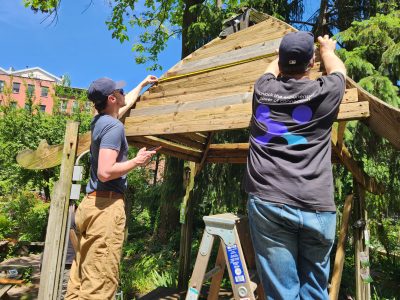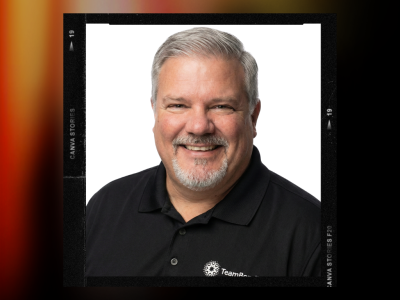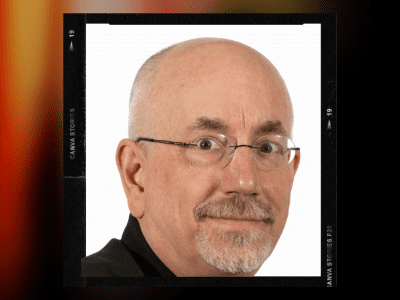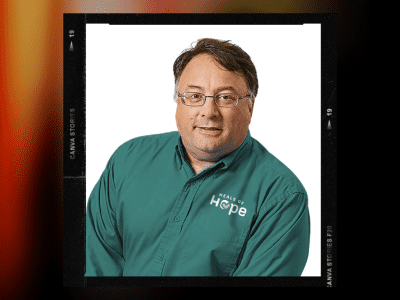STRONG TEAMS DON’T HAPPEN BY CHANCE 
Cultivating Business Relationships
w/Anna Frazzetto
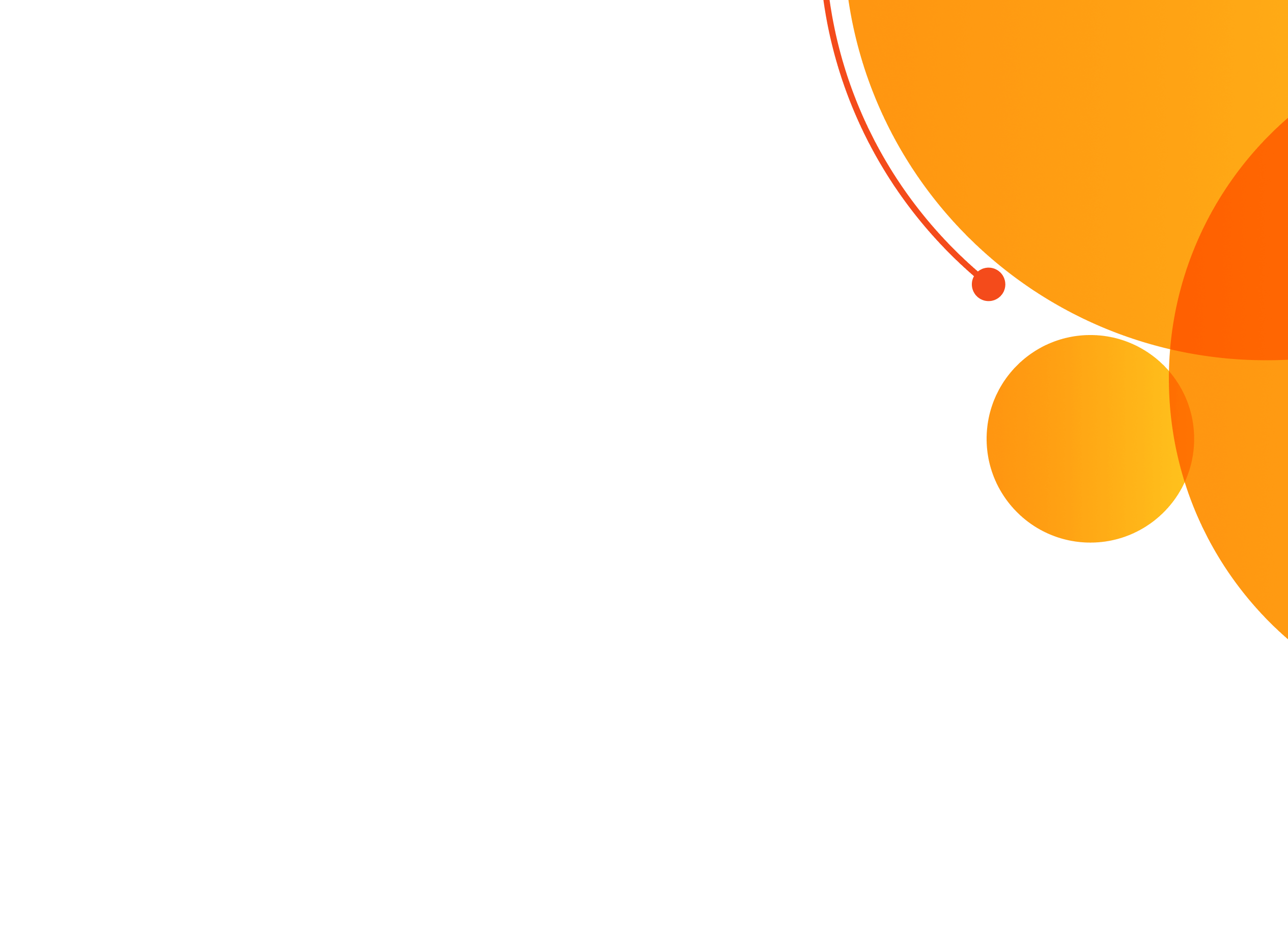
Use the buttons above to listen now.
Transcript - Cultivating Business Relationships
Rich: On this episode of team building saves the world.
Anna: I’ve met plenty of people in my career that felt that if they accepted every single LinkedIn invite and the factor was to get as many people as you possibly could in your network. Right. I think if, if your team members see your vulnerability, That’s a plus that’s a great way to connect team-building activities.
Anna: I’m a huge fan of team building.
Rich: As am I. It’s me your old friend Rich Rininsland host of team building saves the world, the show where I speak to the leaders and innovators in employee wellness and corporate culture on how it reflects in the world of today. And today we’re discussing building business relationships with sales leader and chief digital technology officer at Tential Anna Frazzetto. But first I need to share some love with my supporters at TeamBonding.
Rich: If your team is ready to experience teamwork through the power of play then visit team bonding.com to learn more. Now join me in welcoming one of the top 50 DEI influencers for staffing industry analysts, Anna Frazzetto, hello Anna,
Rich: Anna, that is a small group of people I keep chained up under my desk. They’re here just to applaud you. That is their only job.
Anna: I love it.
Rich: So we are here today to talk about building business relationships. Why don’t we start off forming our relationship? Tell my team out there a little bit more about yourself and how you got into this field.
Anna: Okay. So actually I started off as a, uh, what I would consider to be a tech nerd. I was a double major computer science, mathematics, purely the tech route. I was a developer for years, a systems programmer moved into managing development and teams. And then it was not until I had some great mentors in my life that they said, you know, you have great interpersonal skills.
Anna: Why are you like cooped up, you know, kinda in the back office here. Uh, we’d love to get you in front talking to clients as far as the platform that we just built and you’re relatable as far as getting clients to understand what we do. And that was like slowly how I started to get more involved on the sales side.
Anna: And then as my friends say, I joined the dark side and I’ve been in sales. Oh, my goodness. I’ve been in sales for 20 plus years, but I think the great strength is the fact that I had the development background, because that it makes it very easy to have conversations with tech leaders
Rich: First off, yay women in stem. But when we’re talking about business relationships, what are we specifically mean by that?
Anna: Right. So, you know, business relationships, I think the interesting thing about when you talk about business relationships, I find my best business relationships have always been the ones that I’ve been able to get personally involved in the career of my client or my prospect or an employee or.
Anna: When you start, you know, almost crossing that bridge now. And what do I mean by that? It’s people buy from people at the end of the day, right? So if they trust you and you could be a trusted advisor to that individual, I think the level of authenticity comes out and then you start naturally developing a bond.
Anna: I’ve had clients before they were clients, just because I work with them in helping their sons, you know, resume, get their first job. Meanwhile, there was no business opportunity yet with me. And then finally they would say to me, oh my goodness, I have to do business with you because I feel like you you’ve been so integral part in my organization and me and even in my kids, you know, future. So, I mean, that’s how you do it. That’s how you build those business relationships.
Rich: So is it just between like someone in sales and a client, or are we talking about people within the same department, a department heads with their people under them?
Rich: Are we talking about all levels of relationships?
Anna: Oh, all levels of relationship. I think relationships. When you talk about relationships, I really do think it’s a little bit, like, I always say you look to the left to the right you look above, below you’re developing relationships. It’s a true 360, right? So you need to, even where you work, you need to be able to have that full scope of relationships, but then you need to take that outward, right? How do you work with possible vendors, clients, partners, right. So you need to kind of take that outward and then let’s, let’s not forget talking about mentors, right? The importance of developing that kind of relationship.
Rich: Well, what’s the difference then between a business relationship and networking?
Anna: Okay. I love that question because I’ve met plenty of people in my career that felt that if they accepted every single LinkedIn invite and the factor was to get as many people as you possibly could in your network. Right. Then meanwhile, you don’t have a relationship with a majority of those people. So I actually had a rule of thumb when I, you know, started off with LinkedIn is that I would not accept invites unless I met them.
Rich: Oh, okay.
Anna: Right. Because again, I want to develop a relationship, not just have a meaty, you know, network. Now it’s how do you change your network into relationships? I think is the key, you know, kind of the secret sauce.
Rich: And what is that sauce? Like? What would you consider your secret to going from here’s someone I met through some part of my business who is now a relationship of mine.
Anna: Right. So I find a great way to develop the relationships is if you can find a common ground, right. So if you have, um, you know, for example, when I, uh, was working at, you know, Harvey Nash, or even, you know, at tential, I started a, a women in tech group. Okay. Right. So we started doing a monthly webinars, right. I would invite different panelists, different speakers, and you start developing a relationship by doing that.
Anna: Meanwhile, the people that I was reaching out to were initially within my network. Right. But then how you start developing that relationship is having that contact. Right. And having that discussion. And then you’d just start finding people that want to participate in that type of dialogue. And again, I think that’s a great way to kind of transition into a relationship.
Rich: So what are the benefits of this? I mean, obviously sales and client. That means the client is more than likely to come back to you. And the client knows that you’re someone that they can trust to make them a deal. But what about on the other aspects of your business relationships? What kind of benefits are we seeing?
Anna: Well, I think the benefit that you get is also in looking at your own career, right? Because if you, uh, you know, do you want to be an individual that goes to work and is very siloed in thought, right? Where you go in, you basically check in, I’m going to get my day’s work done, but I don’t necessarily need to interact with anybody outside of the individuals that I work with.
Anna: And then check out. If you look at that, that’s kind of, that’s doing a job. Versus a career, right? So I think that’s the benefit in developing those relationships and gaining personal interests, because then it also helps you, when you look at your career, if you want to advance or possibly go down a different path, you need to have those relationships within the organization to kind of help facilitate that.
Rich: Well, even for those steady, Freddy’s the ones who just love what they’re doing and that’s how they want to spend their time. It’s the perfect schedule for them. They have per great family time, whatever manages to be. Do they still get benefits from building those relationships?
Anna: Absolutely because what’ll happen is it might actually enrich their work.
Anna: Right? Cause they might learn something new, something different by being able to interact with other individuals, not to mention, you could also tap into them for the need of, uh, possibly to support, uh, an external user or a client or a vendor. But what happens is it broadens your circle. I think by doing that, it also makes you aware of things that you might not even know your organization has the ability to do, right?
Anna: Depending on the size company, if you’re in one department, If you don’t expand to understand what the breadth and scope of your company is, you, you might be limiting yourself.
Rich: Plus, as we say in the United States, I mean, there are so many people right now who most of their interpersonal relationships are coworkers.
Rich: So we wind up. There’s just that philosophy in the states where more than a third of your life is spent in the office. So you might as well get to know these people.
Anna: Exactly. You spend more time with them than you do with your family.
Rich: Right? So what do we consider a good beneficial business relationship?
Anna: So I think a beneficial business relationship is one where there’s giving and taking, right.
Anna: It can’t be one sided, so it’s gotta be a two-sided relationship. Right? Uh, I think, um, I’ve done some interesting little, uh, activities or exercises where every person in the organization would spend half an hour with. Two levels above them as far as management structure. So what that does is it helps kind of bridge the gap, but also exposes you to different departments.
Anna: So, but that’s a, that’s a two way street there’s gotta be giving and taking to make it successful.
Rich: And is this something that like, say, let’s look at management levels of companies, should they be helping to facilitate that? Would it be, is it of their benefit to make sure that these things continue to grow?
Anna: Absolutely. Because if you think about it, every, every company on the planet, I would think that their vision would be is that they want to grow, right. They want to be able to expand their business. And you probably don’t want to experience a lot of turnover in your company. So unless you’re having these conversations, you’re not going to know there’s nothing worse to find out some bad news from an exit interview.
Anna: As opposed to having these relationships and you, you kind of have the reach to different levels of the company to, uh, different departments and, and then maybe it prevents your turnover rates. Uh, I think that would be an interesting study actually to see companies that successfully do a great job in getting to know, uh, all the different levels of, of management and operations, uh, and what their turnover rates versus, uh, companies that are pretty much, you know, you have to fit in a box and it doesn’t matter if you talk to anybody.
Rich: Right. So if I’m a leader on a team, And I think my team could really do with some stronger business interpersonal relationships between the team itself, if not with the clients outwards, how can I best go about helping officiate that helping make sure that that becomes realized?
Anna: Right. So, you know, I have to tell you, I think COVID really challenged many leaders and team members across the planet.
Anna: Right? So one of the activities that I started to do is making sure that we would have a get together once a week with the team, with my team. Right. And to be able to talk about non-work activities. Okay. So for us to share with each other. So just imagine this is a group of about 13 of us. And what started happening is that people started to volunteer saying, you know would everybody would be open to having a yoga class together, like awesome. So we have some people that were athletic on the team. Some people that are not, have never exercised a day in their lives and it was hysterical. We would get together via zoom call, but we share and we bond that way. I think that’s how. The simple things that you can do to kind of help build comradery, especially because if you’re not sitting in an office together where you can kind of connect people, the other thing is it’s okay to bring your emotions to work.
Anna: I actually just posted something on LinkedIn, especially with mental health awareness month about the fact that. You know, it’s always been so taboo to talk about, you know, emotions at work, right. You always strictly, it’s kind of like the EQ versus IQ, right. Kind of discussion. And I started opening up with the team and sharing, like what’s, you know, what’s really bothering me about you know
Anna: the pandemic, for example, like we can’t get together. I think if, if your team members see your vulnerability, that’s a plus, that’s a great way to connect. Now. It’s gotta be genuine that like, don’t, it’s gotta be real, but I think people see that you are vulnerable. Uh, just like they are. Well, what ends up happening is you automatically start building that, that team, that camaraderie amongst the individuals where then they’ll do anything to support you and vice versa.
Anna: So that’s how you start that. I, I find that to be very successful. It’s worked really well with me. COVID and non COVID to do that type of activity, to kind of bring people together.
Rich: Okay. Speaking of bringing people together, I need to step away for you for just one quick second, because I need to tell all my team out there about a company.
Rich: I am very proud to be a part of team bonding. Team bonding was founded over 20 years ago with one simple question. How can employees have a great time while fostering strong, authentic bonds between people who work together? They’ve created a catalog of innovative events using the power of play as a learning tool and tapping into the correlation of work and play.
Rich: From scavenger hunts to jeopardy and so much more the team bonding of activities, whether it’s live virtual or hybrid, maximize the impact of team building with an accent on fun. So visit team bonding.com to schedule your event now. Team bonding when you want seriously fun results. And we are back with Anna Frazzetto talking about those very same business relationships and how to build them and make them stronger.
Rich: And as you say Anna yes, COVID changed the world. There is no denying it. Business is not done the same now as it was two plus years ago. So what are we looking at? How has it changed and how hasn’t it changed?
Anna: Well, I, I think the one thing that, you know, talking about the sales side that’s really changed significantly, right?
Anna: I mean, you know, before you could walk into an office and try to develop a relationship with the person that you’re meeting with, by just looking around in the whole. And saying, oh, I see that you’re a golfer or that you belong to such and such organization or that, you know, you could pick something up pictures of kids, like, you know, dog, you know, whatever.
Anna: Like you can start, you know, bonding that way. That’s all done. With Covid right? Because now what was happening is even if you’re trying to develop that relationship, uh, via zoom call, it’s not like you could stare at somebody’s background and go, oh, what is that behind you? Yeah, no, that you can’t, it, it cuts right to the purpose of the meeting.
Anna: So now it takes the relationship off the table, right. When you’re trying to establish that relationship, it’s off the table now because they just want to focus on the business transaction. So the way to do that is, you know, do your research on individuals, right? Do your research and you try to figure out they’re an avid speaker on DEI,
Anna: okay, well then I’m going to reach out to them separate from this business meeting that I’m having. And I’m going to try to pick this person’s brain because I’m also passionate about DEI. So therefore I’m going to get them engaged that way. And so building the relationship has become harder, but it’s very doable.
Anna: I think you just have to find that common ground and you probably have to do a little bit more homework. Initially. This also goes to the non sales side. Right. You know, you do the same thing. You got to know your audience, know who you’re talking to and then be able to try to do that extra homework so that you can connect with that person.
Rich: Is it more important, do you think now to be able to do that? When you have people who, I mean, so many people were still hearing want to stay home. They actually still, they like the hybrid model and they want to keep working with everyone just like a two by three in square, on their screen. Is it still important that we keep these business relationships going or the networking going as it is because now these people have their families.
Rich: They’re right there on the other side of the wall, where once there was a cubicle. So do you think it’s more important or even as important as it used to be?
Anna: I think it’s as important as it used to be. And maybe in certain aspects, it’s actually a little bit more important because especially if you’re trying to break into a new relationship, it’s a little bit harder to navigate that when it’s a hundred percent remote, you know, as far as working from home, I think.
Anna: Everybody was craving for some, um, work-life balance. Right, right. We all talked about work-life balance. We all pretended we had work-life balance but the reality is most of us were not very successful. At least I personally, I don’t think I was very successful at work-life balance.
Rich: Work-life balance usually just meant you liked your job.
Anna: Right. And your job became like your life, right. So, you know, it w it was not just a job, but it became like almost the lifestyle that you constantly work. Yeah. I agree. So I think, um, Uh, that, that’s the part that we all need to kind of learn to hang on to. I think a lot of companies have struggled. I’ve seen it where they’ve, you know, forced, we’re all coming back into the office and they’ve had massive boycotting and even resignations from, you know, like we’ll know that I’m not going to work under that situation and go do something else.
Anna: So it’s, it’s tricky. It’s a slippery slope. But I think we need to be able to navigate it because it’s here to stay. I don’t think a hundred percent in the office, you know, maybe I don’t have a crystal ball, but I think it’s going to be really hard to go back to a hundred percent in the office
Rich: Being a part of this podcast. I have learned so very much because the business world was not something that I ever thought I was going to be a part of. At least, you know, tertiary really sure but not my life. And just being part of the podcast I’ve learned so very much, like I remember just a year ago when everybody was saying, no, we want to stay home.
Rich: We’re working just as well, if not harder at home than we were at the office. But now I was reading an article just in preparation for today for meeting you. And it’s like 78% of the workforce wants to be back in the office because they miss shaking hands. They miss being able to look somebody in the face over a water cooler.
Rich: Do you agree with that assumption or was that sort of a hopeful guesstimate on the part of the article?
Anna: Well, you know, I, I would say 78% seems really high because I, yeah, because the conversations that I’m having and even that I’m kind of noticing from LinkedIn, for example, people are really pushing for the, uh, the hybrid model.
Anna: I think what happens is it really, it allows you to be able to to take your children to school, for example. And then, you know, you come back and you’re back online. And so I think when it’s hybrid, I think it’s going to give you the pleasure of being able to be in the office two days a week, for example, and you get to interact and socialize, but then you can have three days at home or vice versa as somebody.
Anna: I know some people are flipping the weeks when they do three days and then two days, and then two days and three days. So I think it’s here to stay. And I think it’s just a matter of us being able to, you know, work with it.
Rich: Is there a right way or wrong way to do it? If we’re doing it just hybrid wise, just virtually
Anna: I, you know, I mean wrong way.
Anna: I, you know, I guess that that’s something,
Rich: Or is it kind of just standing as long as you’re trying something, if there’s a benefit to it?
Anna: Exactly. Uh, you know, we’re talking about, I mean, the podcast that I’m on right now, like team building activities, I’m a huge fan of team building. Um,
Anna: you know why? Because, you know, honestly, it’s a great way to connect people. We’ve done things with, uh, you know, especially when I was at Harvey Nash, we used to do things even with our clients which was great because then it also shows that you’re not all business, that you have that personal side to you. During the pandemic,
Anna: uh, we were trying to celebrate the success of an author and we couldn’t come together because obviously COVID happened. So we were going to go to, you had mentioned SIA at the beginning of this, but it was like their executive farm. We were going to go and celebrate, uh, Joyce Russell. She wrote this fabulous book chairing on top and unfortunately.
Anna: We couldn’t get together. So we wound up saying, oh my goodness, like, what do we do now? So we didn’t just walk away and say, okay, it’s COVID, we’re not going to do anything. We wound up establishing a, we call it the lady leaders book club, but we wound up establishing a monthly get together, but it became like a, an avenue of support.
Anna: For each of us. So it was 15 women. We came together. Uh, we actually, during COVID we wrote a book together. So it was, it was amazing. So I think like there’s so much that you can do out there that allows you to, uh, connect. Even if you are separate because you want to have work-life balance or because it’s COVID or it’s something else, but it was a great way to pull us together.
Anna: And we never thought that we were going to write a book, but we did a it’s called together. We rise and it’s about women. Right. It’s about women leadership and it’s all of our stories as far as how we’ve become the leaders that we are today. But the reason why I shared this is that COVID actually gave us an opportunity to do something together that we probably wouldn’t have done.
Anna: If it wasn’t COVID because our schedules would have been so chaotic because we were always in the office or traveling right from work, uh, that we would’ve never been able to do it.
Rich: Okay. Excellent. Self promotion, by the way, I applaud you for that, that book again, together we rise. Where’s that? On Amazon, fan tastic.
Rich: Now all my team knows and they will go and look for it. I love it. Now, what about the different generations? Because you know, you’ve got five different generations currently existing in the workforce. Are we seeing that the older groups, uh, we’re talking about the greatest generation and, and, and, you know, down to the Xs, like me down through the millennials and the Ys do they do this differently?
Rich: Is it the same? Do they even have a common ground to talk about?
Anna: Well, you know, I think everybody has a common ground to talk about something they’re there. There’s always something out there. So if you take somebody who is, you know, a, a gen Z whose work might not be their primary focus right? Because they have so many other activities and things that they’re participating in.
Anna: And then you might have like the more traditionalist of a baby boomer who is still hanging on to the work, to the work environment and that to them work is, and now of course I’m generalizing for the purpose of conversation. I’m not saying here in these categories are like that, but that their work is everything, but I’m sure.
Anna: There’s a common issue or common talking point. They might have different perspectives and different opinion on that talking point, but it’s a way to bring people together to have the conversation. Right. So for example, you think of the conversation about microaggression. What is it, what does it mean?
Anna: You talk to an older generation. They might not be as aware of what microaggression really means. Now you talk to a gen Z person and they’re all over it. They know exactly what it is. So, but now it becomes an education. Right. And it’s a great way. Um, I’ve seen this work really well, where you have different training sessions within a company that maybe they do bridge across many generations and you have a training session to kind of share different thoughts and perspectives and how to handle different situations.
Anna: So again, there’s always a way to bring people together. They might not have the same opinion, but there’s a great way to at least have a talking ground.
Rich: So far. It doesn’t sound like there is any real bad or downside to cultivating these business relationships.
Anna: Exactly, exactly. I’m a big, big proponent of it.
Anna: And also, I, I constantly, I have a philosophy that says, even if you’re in your current job, you should always be looking at what your next career move is going to be right. Not that you’re not focused in what your current position is, but you always should have that, that broad landscape where you can say, I think in the next three to five years, I see myself here or in the next 12 to 18 months.
Anna: I see myself here. When you have these different talking discussion groups, it exposes you and broadens your perspective.
Rich: Thinking about those older generations. Because whenever I think about. Networking and I think about building personal relationships. I think about like when I was even starting out, I’m an artist in my lifestyle.
Rich: I’m, I’m an actor, I’m a director, I’m a writer. These are the things that I do. This is how I built my career, but I still had to have those jobs that kept my career going. And I always remembered the old philosophy of keep a pocket full of business cards, because you never know who you’re gonna meet.
Rich: What’s different now from that, like what are the, what are the new generations coming in to?
Anna: I think it’s it’s in knowing how to communicate. Right. Communication styles. Cause you were talking about, you know, like a pocket full of business cards nowadays there’s digital cards, right? So a lot, a lot of companies don’t even have business cards because you have a digital card or you use LinkedIn
Anna: as your business card and you just scan the QR code, for example, versus having, I know it’s a totally different world, right? So you kind of figure out a different way to be able to communicate. But the reason why I say communication style is because again, looking at it from a sales perspective, if you’re, you know, 23 years old and you’re trying to sell to somebody who’s, you know, 55 years old, not that age has anything to do with it.
Anna: Right. Understand how they would shop. How they would buy. Right. So for example, texting might not be what they’re into texting a message to a new prospect who’s in their late fifties or early sixties, they’re going to be like, this is spam and they just delete. Right. I mean, you know, versus they might be more, they want the formal style of an email.
Anna: Yeah. Yeah, they’re big email people. So again, know your audience. So I think communication style is one thing that everybody needs to be sensitive to and how you’re going to engage with whoever you’re going to engage to. And this would apply even on a non-sales way.
Rich: Yes, absolutely. I try to tell my 16 year old daughter
Rich: who is in the next room. She’s literally a hallway away from me, but she’s texting me and I keep yelling to her. I’m not wearing my glasses. I can’t see this. Come talk to me. And she’d be like, she’d be like no, And then call me, oh, that’s talking on the phone. I can’t do it. I don’t want to do that. Yeah. Yeah.
Rich: I’ll say I’ll do like, I’ll tell her to call her grandmother who lives a hundred miles away from us. And she’s like, but that’s talking on the phone and grandma doesn’t know when to stop. And it’s because she’d rather be texting. It has nothing to do with the fact she doesn’t. I mean, she loves her grandmother very much.
Rich: Mom, if you’re listening, she loves you very, very much, but yeah, she’s just used to texting and that’s all, she knows really how to communicate with, but let’s look at it from then her perspective, because very soon she’s going off to college and she’s going to be, you know, going into a business field somewhere.
Rich: She’s going to be going somewhere to do things. What kind of advice can we give her? On how to start these relationships early to cultivate that network, that’s going to help her, right?
Anna: Oh, so I’m, I’m a big fan of LinkedIn. And actually I encourage, I told all the kids in my family, you know, my nieces, my nephew create your LinkedIn profiles.
Anna: So when they were like 18, just getting into college, I’m like start create your LinkedIn profile and start connecting with other college students. Right. Then what happens is you start building a little bit of a base. Then if you know that your professors are on LinkedIn connect with them because then you could see who are they connected to.
Anna: So then when you’re starting to get ready to look for, you know, your first business opportunity, you start having a base of who you can reach out to connect with the members of your family. Guess what? They’re not just aunts and uncles and dads and moms, they have, they have professions and it might be a profession that you might be interested in going into.
Anna: So these are all, I mean, I think it’s like start early with that professional approach. The other advice that I give a lot of teenagers, older teenagers, you know, in the 16, 17, 18, 19 20 range that whatever you do in social media, will live on forever.
Rich: Very true. Yes.
Anna: So just be, be smart in how you go about approaching things.
Anna: Uh, I know that I’ve worked in organizations in the past when, uh, we would look to hire someone, we would do a full social media search. On that individual. So you might think that you deleted your Instagram pictures and your ID, but guess what? It will come up in a search. So just be smart and think longterm, uh, when you’re posting some of those, uh, those pictures,
Rich: Are they still gonna hold something against like a new hire for something they did?
Rich: Cause now my daughter has things from when she was five on Instagram and Twitter. And what have you, are they still going to hold that against her when she is older?
Anna: It depends, honestly, it depends on the company that you’re going to go work for. I think some of the larger companies and some of the more conservative industries, uh, they might.
Anna: Uh, might hold it against you. But if you’re like, for example, if you’re going into the media and entertainment business, I’m sure they’re probably not going to hold it against you as if you were going to financial services, they might have a different landscape on, you know, uh, you need to have what they consider to be a pristine record.
Rich: Anna uh, thank you so very much for coming on and talking to us about this. This is a fantastic launch for this kind of conversation. I’d love to have you back in some future events and we can talk a little bit more in depth about things. Fantastic team. Please give a big round of applause to Anna Frazzetto.
Rich: Why don’t you tell everybody out there Anna where they can find you in case they have any further questions or, or just want to get to know you a little better?
Anna: Excellent. LinkedIn is the best way to find me and it’s my name anna Frazzetto. So that’s the best way to get me
Rich: Fan tastic. I hope you had a good time today with this.
Anna: I did very much. So this was just a lot of fun.
Rich: Good. Cause now we’re going to have some even more fun it’s time for a speed round.
Rich: there’s no cheese left unturned. All right. As I was explaining to you before the show began, this is simply 60 seconds of innocuous questions. I’m going to play music that goes for 60 seconds. During the course of that time, I’m going to be asking you a series of just silly, simple questions. The objective here is to answer as quickly as you can, as shortly as you can try to give quick off the top of your head answers.
Rich: And we’ll see if we can get, you know, how many we can get out of you in the time that’s lapsed. Right now, we’re looking at 13 is the number to beat. That’s a tough one. It’s a tough number. Most people are getting around 10 11. So let’s see if we can’t get you all the way. All right. Anna once you hear the music, I’ll start asking the questions and a way we go.
Rich: What’s your name? My children. You have three, two. One’s your favorite? None. Do you have any pets? Yes. What are they? Dog. Excellent. Cake or pie? Hi. What’s your dream job. Oh,
Rich: traveling the world. If you could be on any television family, which one would you choose? Friends. Who’s your favorite celebrity chef. Oh, by flight.
Rich: What is your favorite trait about yourself?
Anna: Um, go getter.
Rich: Who is your celebrity crush?
Anna: Oh, Harry styles,
Rich: Nice. If you could ask your dog one question, what would it be?
Anna: What do you really like to eat?
Rich: Would you rather be considered popular or smart? What do you like to do on a rainy day? Watch movies. I’m going to put it in there.
Rich: Anna are you ready for that? 14 you are now our number to beat. yeah.
Rich: Congratulations. Well done. Oh, anything, anything you’d like to say out there? Kind of like a, a victory moment for yourself.
Anna: I like to thank my mother and my father.
Rich: Oh, fantastic. And historic day here. Thank you so much again. Thank you team. That’s it. We have put to bed. Another episode of team building saves the world. If you’ve enjoyed this episode, whether you’re new to the podcast and old fan of the show, please be sure to share it with everyone. You know, whether they, your coworker, friend or family, it helps us to share all this vital information you can find out all about us, including all past episodes@teambonding.com slash podcast.
Rich: You can also find us wherever you find your favorite podcasts, Google podcasts, apple podcast, Spotify. You go to listen, we will be there. And if you don’t find this where you listen to please find us on the social medias at team bond podcast and leave us a message telling me where you are, because where you are, is where I want to be.
Rich: Let’s go on those social media is tell us whether you liked this show, or if you have an idea for a future topic on the podcast, I want to hear from you. So before we say our final farewells for this episode of team building saves the world, please never forget that if you’re within the sound of my voice, you’re on my team.
Rich: And I am forever going to be on yours so long team. And I’ll see you next time.
Rich: It’s been said that you learn more about a person in an hour of play than in a year of conversation. So why not put your coworkers to play with the help of the team at team bonding team bonding was founded over 20 years ago with one simple question. How can employees have a great time while fostering strong, authentic bonds between people who work together?
Rich: Their catalog of innovative events include scavenger hunt, jeopardy, and much more each activity, whether live virtual or hybrid maximizes the impact of team building with an accent. There’s a team bonding.com to schedule your event now, team bonding. When you want seriously fun results.
June 6, 2022
The key to a successful organization starts with engaging your employees and establishing strong and meaningful connections.
Listen as Host Rich Rininsland speaks with Sales Leader and Chief Digital Technology Officer at Tential Anna Frazzetto on how to cultivate business relationships to build an active network, and strategic ways to improve employee relations.
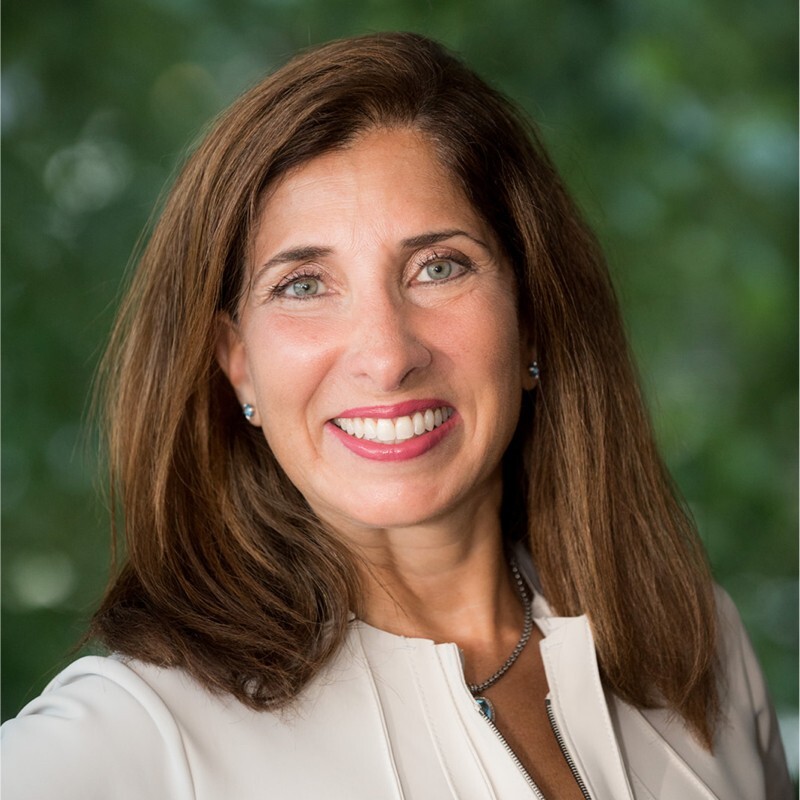 Anna Bio: Anna Frazzetto, a first-generation Italian immigrant, shares the value of looking back to understand how the strength and persistence of our immigrant families shape who we are today. At a time when diversity and inclusion remain elusive, our roots reveal the commonality of what our immigrant families, regardless of country origin, worked for – a better life for their families, neighbors, and co-workers.
Anna Bio: Anna Frazzetto, a first-generation Italian immigrant, shares the value of looking back to understand how the strength and persistence of our immigrant families shape who we are today. At a time when diversity and inclusion remain elusive, our roots reveal the commonality of what our immigrant families, regardless of country origin, worked for – a better life for their families, neighbors, and co-workers.
As Senior Executive, throughout her career, Frazzetto has experienced IT and business workflows from different regions and cultures. She has led global teams to support organizations throughout North America and the APAC region, from start-ups and growing multinationals to global industry leaders. Anna’s passion is driving sales and revenue growth for an organization.
Frazzetto is a sought-after speaker on digital innovation, outsourcing, and workplace diversity and is an advocate for increasing the numbers and influence of women in technology. She was named to Staffing Industry Analysts’ 2018, 2019, 2020, and 2021 Global Power 150 Women in Staffing lists and serves as the national chair of ARA, an organization aspiring to attract, retain and advance women in IT. She has also been named to the Global top 50 Diversity Influencers in the world. Her passion is to create a more equitable world for future generations including her nieces, nephew, and grandkids.
Depending on the size company, if you're in one department, if you don't expand to understand what the breadth and scope of your company is, you, you might be limiting yourself.
Anna Frazzetto

More great podcast episodes.
Season 6 | Episode 18
That’s a Wrap!
Season 6 | Episode 17
Work-Life Integration
Season 6 | Episode 16
Laughing it Off
Season 6 | Episode 15
Corporate Volunteerism in Action
Season 6 | Episode 14
Collaborative Play at Work
Season 6 | Episode 13
The Science of Supportive Workplaces
Season 6 | Episode 12
The Power of Being Present
Season 6 | Episode 11
The Age Advantage




